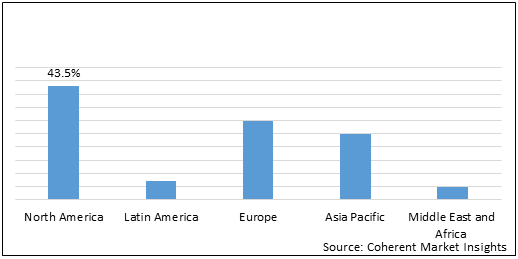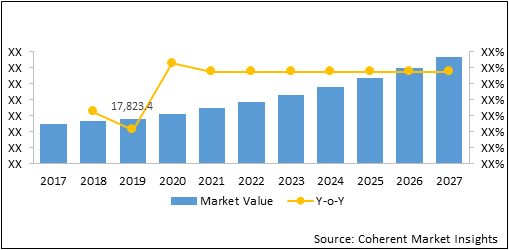
A video game console refers to a computer device that allows one or more people to play the video game. The term video game console is majorly used to distinguish a console machine to play video games in contrast to arcade machines or home computers. There are various types of video game consoles including handheld game consoles, dedicated consoles, home video game consoles, and micro-consoles. Connected game consoles have evolved significantly over the past, with availably of Wi-Fi connectivity, better graphics, and higher definition image quality. The global connected game console market focuses on seven regions namely North America, Western Europe, Japan, Asia Pacific, MEA, and Latin America.
The global Connected Game Console Market was accounted for US$ 13,818.1 Mn in terms of value in 2019 and is expected to grow at CAGR of 11.5% for the period 2020-2027.
Market Dynamics-Drivers
Consumer expenditure on games and gaming equipment has increased significantly in the recent past. Furthermore, consumers are increasingly spending on different video game accessories such as controllers, light guns, joysticks, and more. According to Coherent Market Insights’ analysis, North America held the dominant position in the global video games market in 2014, accounting for US$ 15 billion in terms of revenue. Thus, these factors are expected to drive growth of the global connected game console market during the forecast period.
Broadband penetration has increased worldwide, especially in developed countries such as the U.S. and Canada. As a result of this, the demand for gaming consoles has increased with connected game console providers pushing sales of connected game consoles. According to the International Telecommunication Union (ITU) report 2013, in developed countries, around 77% of the total population has access to the internet as compared to 7% in emerging economies. Furthermore, according to the same source, Europe reported the highest broadband penetration of 75% followed by North America and Latin America with 61%. Hence, rising broadband penetration is expected to propel the global connected game console growth in the near future.
Statistics:
North America held dominant position in the global Connected Game Console market in 2019, accounting for 43.7% share in terms of value, followed by Europe and Asia Pacific, Latin America and Middle East and Africa respectively
Figure 1: Global Connected Game Console Market Share (%), in terms of Value, By Region, 2019
To learn more about this report, Download Free Sample
Market Dynamics- Restraint
Although consumer expenditure has increased over the years, the prices of game consoles have risen similarly. With the introduction of new technologies and upgraded versions of consoles, the price of connected game consoles is increasing too. Therefore, these factors are expected to hamper the global connected game console market growth in the near future.
Smartphone gaming is increasing rapidly across the globe, especially in emerging economies. Game development time for mobile games is far lesser than that for game consoles. Moreover, most mobile games are available for free or cost substantially lesser than those for game consoles. This is affecting growth of the market to some extent. According to the Ericsson Mobility Report, smartphone ownership was reported at 1.3 billion in 2012 and is expected to grow to 5.6 billion by 2019. Thus, these factors are expected to hinder the global connected console market in the near future.
Market Opportunity
Game console manufacturers are focused on research and development activities and investing substantially, in order to introduce innovative features in their consoles. With this, market players can capitalize on opportunities and gain a sustainable advantage over their competitors and enhance their consumer base. For instance, in 2013, in 2013, Microsoft Corporation’s R&D investment was valued at US$ 9.8 Bn.
Key companies in the market are focused on collaboration and partnership activities, in order to enhance their market presence. For instance, in 2014, Nintendo collaborated with Yoplait USA, Inc., a yogurt providing company to place characters such as Mario, Luigi, Peach and Bowser on the side of Yoplait’s Petits, Filous, and Frubes products. The objective of this collaboration was to enhance the company’s visibility in the market.
Figure 2: Global Connected Game Console Market Value (US$ Mn), 2017 - 2027

To learn more about this report, Download Free Sample
The global Connected Game Console market was valued at US$ 13,818.1.4 Mn in 2019 and is forecast to reach a value of US$ 33,30,1.3 Mn by 2027 at a CAGR of 11.5% between 2020 and 2027.
Market Trends
Virtual reality (VR) gaming has gained significant popularity among consumers in the global connected game console market. VR gaming offers enhanced experience of gaming with a virtual environment wherein gamers can interact with the game though body and hand motions. This trend is expected to continue during the forecast period. For instance, in 2014, Sony Computer Entertainment Inc. introduced Project Morpheus’, a system that allows for VR gaming on the PS4.
Connected game console offers enhanced entertainment features such as video streaming, Blu-ray DVD video playback, and internet browsing. Moreover, it also allows access to video streaming services such as Netflix and YouTube.
Competitive Section
Key players operating in the global connected game console market are Microsoft Corporation, NVIDIA Corporation, Sony Corporation, Nintendo Co. Ltd., Valve Corp., OUYA Inc., PlayJam, Mad Catz, and BlueStacks.
Key Developments
Share
Share
Missing comfort of reading report in your local language? Find your preferred language :
Transform your Strategy with Exclusive Trending Reports :
Frequently Asked Questions
Select a License Type
Joining thousands of companies around the world committed to making the Excellent Business Solutions.
View All Our Clients